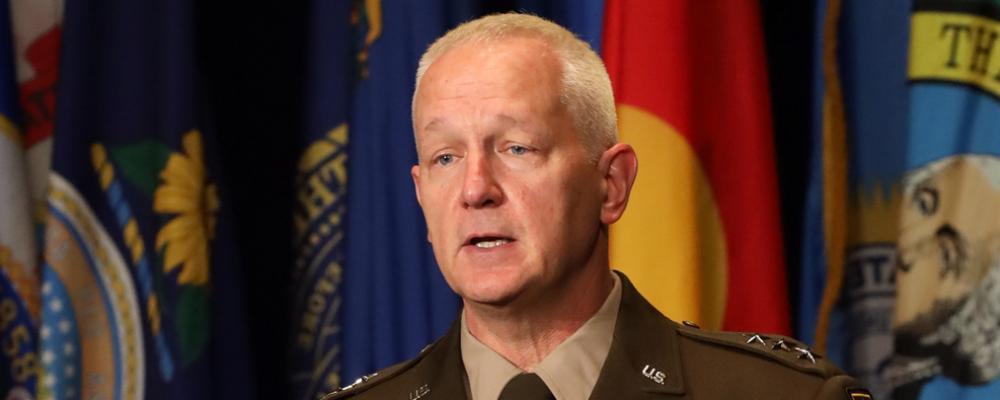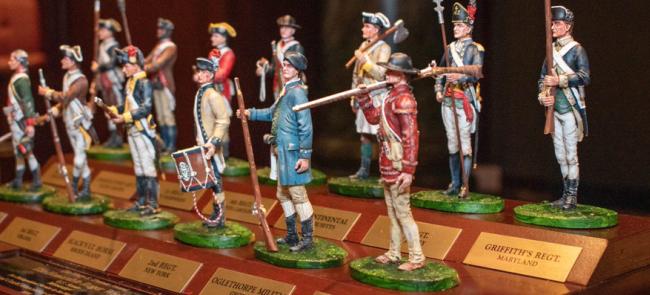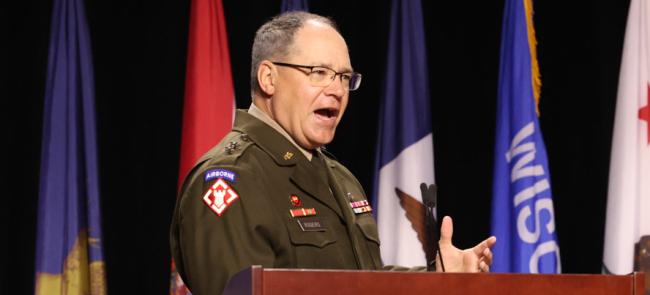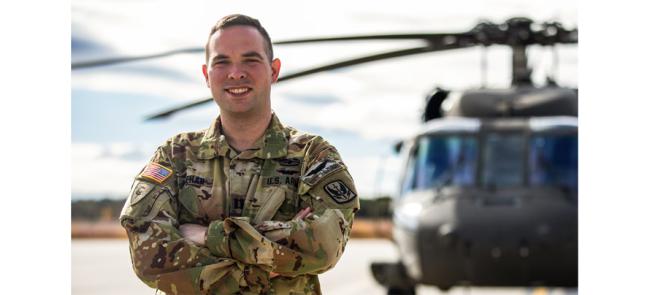
A Conversation with Lt. Gen. Jon A. Jensen
Lt. Gen. Jon A. Jensen had somehow escaped an assignment in Washington, D.C., during a 38-year career in uniform that has taken him around the world.
That was until Aug. 10 when he took over responsibility for coordinating federal programs and policies affecting 336,000 members of the Army National Guard.
But while he is new to life inside the beltway, nobody knows the Army Guard better. Jensen has spent his entire career in the force, commanding at every level — company through division. And he arrived in the nation’s capital after serving three years as the adjutant general of Minnesota.
Jensen spoke with NATIONAL GUARD over the phone recently. The conversation spanned his first few weeks on the job, the challenging year that’s nearing an end and the way ahead for the Army Guard.
You’ve been on the job here in the D.C. area for several weeks now. What have you learned about the Pentagon and Washington in that time? Anything surprising?
I’m still counting days. I haven’t gotten to the point where I’m counting months yet. I think I just passed over the hundred-day mark. As I jokingly told part of the team, I just now feel like I might actually be contributing and not taking away energy.
What surprises me? I don’t think it’s necessarily a surprise, but coming in from an adjutant general, we really live in the year of execution. If I was still the TAG of Minnesota, I’d be fully focused on the fiscal year ‘21 budget and executing that to my greatest capability. As the director of the Army Guard though, we are really a couple of years out. That’s where our focus is and trying to understand where is it and how is it that we can impact. For right now, our focus is really on 2023 and not the current year. It’s about influencing the future.
Surprises, again, not really any surprises. We’re a large complex organization, but at the end of the day, it’s still about people, soldiers, families, employers. It’s still about leadership, positive leadership, engaged leadership. It’s still about being prepared. Being prepared for not just the unknown, being prepared to brief Army senior leaders on the issues of the Army Guard, being prepared to talk to our congressional teams out there about the Army National Guard, what our challenges are, what our successes are and what the future entails for the Army Guard.
You mentioned looking ahead and you specifically said 2023, but I would imagine that some of what you are working on won’t truly impact the force for another five or 10 years, maybe well after your tenure.
Yeah. Obviously, the Total Army being led by the chief of staff of the Army, General [James C.] McConville, we are really focused on modernizing the Army and that’s a Total Army focus. That takes us all the way out to 2035. We are all involved in that process and that process is over several Army headquarters and commands. What the Army is going to be and what our capabilities are going to be and what component those capabilities are going to reside in, that’s being shaped right now.
Then it’ll be upon us and the adjutants general of the National Guard to go execute that. Yes, certainly, we are all the way out to 2035 right now, which is a very exciting place to be. There’s a tremendous amount of opportunity and capability that will come to the Army Guard as part of this modernization effort. Certainly, there are a lot of hard work, a lot of tough decisions to be made associated with that. I feel very confident in the approach the chief is taking because all three components are involved in every echelon of this process. The Army’s united here as we’re moving forward on this modernization.
Speaking of modernization, you hear a lot about future vertical lift, about long-range precision fires. Is there anything in particular that you see having a big impact on your everyday Guardsman when you are looking ahead?
We’re going to have similar systems, but have greater capability. We’ll have some type of aviation. We’ll have some type of indirect fire, but what’s really, I think, exciting about the future, is there’s new capability that currently does not exist in the Army that we will bring into all three compos.
For example, a multidomain task force. This is going to be a headquarters element that’s going to help synchronize and coordinate all warfare across different domains — space, information, cyber. When we look to the future, I think while we’ll maintain our general-purpose formations, we’ll also grow some unique, special formations and capabilities, as well, as the Army becomes more and more involved, more and more engaged and more and more capable in space, cyber and information. I think those are some exciting opportunities for our future soldiers.
How do we ensure our most talented officers and NCOs and warrant officers get the opportunity to serve in our divisions.
We have spoken previously about the division alignment that’s underway (September 2020 National Guard). Can you talk a little bit more about how this is going to impact officers at the brigade and below level?
As the Army organizes, again, under divisions as the decisive formation of large-scale combat operations, the Army Guard will be likewise organized. We have divisions, we have brigades. That part of this is going to be fairly easy to do I believe. The impact of that on our company commanders, our company-grade officers and our junior-grade officers is going to be, I believe, more opportunity.
One of the things that we have to look at is, how do we ensure our most talented officers and NCOs and warrant officers get the opportunity to serve in our divisions? We only have eight of them. And I would say that the division alignment will provide a larger talent pool for division commanders to select from for key positions. It will also provide a larger talent pool for adjutants general to select division commanders and deputy commanding generals.
It’s all about talent management, getting our most talented people to those key assignments. Understanding though, that we stay true to the National Guard model, which has served us very well, and this is we’re organized by state. The decisions here are run through our adjutants general. It’s not the chief of the National Guard Bureau or the director of the Army Guard who’s forcing personnel decisions down at that level.
What we want to do, what General [Daniel R.] Hokanson and I want to do, is we just want to widen that talent pool for some of these key positions. I think young captains, young majors will get opportunities that they may not have gotten in the past when we were really focused on the brigade level as a decisive echelon.
The division headquarters as they exist right now have been fairly busy in recent years. There’s always one or two of them deployed for Operation Spartan Shield or another mission. How will those experiences help with the transition to a division-focused force?
I’ve served in the division headquarters and, if you look at depth of talent, they are the most capable headquarters that we have in the Army. That’s because of the great plate that’s in a division. You look at just the intellectual capacity of division headquarters and what it can bring to solving complex problems. It’s unmatched.
It’s not just a big brigade headquarters. It’s significantly different. When you take that capability, and then you add the experience that you just mentioned, whether it’s current experience in OSS or previous experience in OIF, like the 36th Infantry Division, the 34th Infantry Division and the 42nd Infantry Division, that makes an incredibly capable headquarters element that can do mission command over large geographic areas involving tens of thousands of soldiers.
It’s a great capability. Also, domestically we can take those skills, we can take that great capability, we can take advantage of the experiences that we have and really apply it to very complex situations.
When we talk about modernization, it's not just about equipment.
What about those units that don’t fit into a divisional structure, like your troop commands. Will division alignment have any impact on them?
Here’s what we know as part of modernization with the Army. When we talk about modernization, it’s not just about equipment. We have a tendency to focus on equipment, but it’s also modernization of how we’re organized as an Army: What type of organizations exist in the Army and to what level, to what size to create what type of capability?
It’s also a modernization of processes. For example, talent management is becoming a significantly stronger focus for us. What I tell everybody is that if your formation doesn’t line up directly underneath a division, that’s OK, you still have value. You’re still going to add value to the Army because we’ll have formations that will be actually at the higher level then, that will be organized underneath a corps. But troop commands are [Table of Distribution and Allowances] force structure and traditionally TDA force structure is nondeployable force structure.
What we want to do is revalidate all of our nondeployable force structure to make sure that it’s not too big. We have a force-generation requirement in the Army Guard. We do need some TDA structure to help on the institutional side of the Army, as it relates to force generation, as it relates to Army education programs. What we want to do is make sure that force structure, that nondeployable force structure, isn’t larger than what we need.
It’ll be the entire Army that is going to be looked at to modernize, to ensure that we can meet those threats that we’ve identified out on the horizon. That’s the key.
COVID-19 has impacted a lot of training schedules and professional school plans. At the NGAUS conference in August, you mentioned the loss of 18,000 school seats this year. How has that affected training and personnel readiness?
I think it’s a natural conclusion to come to, that as we lost school seats, as we lost training opportunities, that’s certainly going to have an impact on our readiness. As we missed our [inactive-duty training] periods, where we spend a lot of time focused on personnel readiness, that we were going to lose some of that personnel readiness.That’s true.
That being said, we’ve still been able to deploy those formations that were needed to support the warfight. The TAGs have done a great job of ensuring that those formations have been postured to meet those readiness gates. Meanwhile, we have taken part of our force and we have committed it to the COVID-19 response. We have enough depth in the Army Guard, because we’re 336,000 soldiers, to meet the challenge of COVID-19, civil unrest, hurricanes, wildfires, and such while meeting our [Global Force Management Allocation Plan] requirements as well.
The depth of our formation has allowed us to do multiple things at one time and meet different priorities simultaneously. We do that with our great partners from Army Forces Command, our great partners from First Army, and it’s executed by our adjutants general.
Understanding what a given priority is at any given time and being able to meet those, I think, is one of the amazing things about the Army Guard. Look, during COVID, we’ve done a relief in place of a division headquarters in OSS. We have done a relief in place of a combat aviation brigade in Southwest Asia. We’ve done a relief in place of armor brigade combat team in Southwest Asia, and a lot of other things. Those are three large formations that we were able to prepare for readiness and then send them to meet their overseas requirement, to relieve Army Guard formations back to the U.S. It’s challenging, but we have the depth in the Army Guard to meet that challenge.
What are your lessons learned from this challenging year?
I will tell you that it’s a combination of my experiences as being the adjutant general of Minnesota, as well as my hundred days up here. I think there are a couple of things. First off, that cohesive teams can accomplish more than what we can sometimes envision for them. I’ll use my personal experience in Minnesota. We had some very cohesive teams that when asked to do some very difficult things rose to that challenge, did it in a complex environment, short notice, maybe not completely 100% prepared for the mission, but went in and accomplished it.
The second lesson I would tell you is that our great teammates over in the Air National Guard have great capability, too. We need to account for that capability and we need to employ that capability to everything that we do. It can’t just be the Army Guard. We have over a hundred thousand Air Guardsman that want to contribute as well.
The other thing is, these are our communities where we live and serve. What impacts our local communities can impact our National Guard as well. The same pain, same frustration that is being felt in the community is going to be felt in our formations. Acknowledging that, addressing that and leading our soldiers through that is very, very important, as our governors and as the president of the United States looks to the Army Guard and to the National Guard, to help meet certain requirements, whether abroad or here on the home front.
I think those are just three quick things that I learned from my Minnesota experience as well as my short time here as the director. I think the one that we would always talk about, and I want to make sure to note is just the quality of our soldiers. I would expand that to the quality of airman that we have in the National Guard and their commitment to their mission. It’s amazing.
Full-time manning will always be a priority for the Army Guard because it's a priority for our adjutants general.
We sit down with each new director and it seems it has become sort of a tradition to ask about increasing full-time manning. That has long been an issue for the Army Guard. Can you tell me, do you see any headway?
Full-time manning will always be a priority for the Army Guard because it’s a priority for our adjutants general. Ensuring that we are fully resourced to meet the readiness requirements that the Army has placed on us is always important.
What I would like to see us do is move away from the temporary employment that we do. I call it temporary. We’ll give a unit preparing to deploy resources to bring on soldiers in a temporary status to help solve some of the challenges it has to get ready. After the deployment, that temporary help leaves and some of the challenges the unit had prior to mobilization return. We’ve got to get out of that cycle. The cycle we need is to identify the problem and solve it. Then it’s solved for good. I think an increase in full-time manning certainly can help us do that.
Another impact of COVID-19 has been the delay in the transition to the Army Combat Fitness Test. I know there was some concern among some Guardsmen about preparing for ACFT prior to the pandemic. What advice do you have for Guardsman looking ahead to the new physical fitness test?
I think this physical fitness test is no different than our previous one, the APFT. First of all, you have to actually work out in order to be successful. What I’m asking soldiers to do is, Hey, let’s focus on our core strength. Let’s focus on some upper-body strength and don’t forget the cardio piece of this thing. While you may not have a pull up bar, for example, outside your home, what are alternative things that you can do to help develop that strength you’re going to need to do that? There are a lot of things that we can do to help prepare that aren’t exactly the test.
Do what you can, work out, continue to live a healthy lifestyle. When the time comes, we’ll be ready, we’ll be prepared and we’ll do whatever fitness test the Army has employed, whether it’s the current one or whether it’s a future one.
What we’re really asking all of our soldiers to do right now is go take the ACFT. The Army needs the data of our ACFT participation, so they can conduct the right analysis and make the right decisions. We can’t forget our individual soldier responsibility to prepare ourselves physically for our military mission.
People and plants grow towards light, so be a positive leader.
You find yourself in position at the head of the Army Guard where you potentially could be a mentor for a lot of soldiers. Can you talk a little bit about who your mentors were and if there was any particular advice you received early in your career that you still adhere to?
One of the great Army leaders I was exposed to as a lieutenant and a captain was [retired] Lieutenant General Roger Schultz, the former director of the Army Guard [1998-2005]. This was back when he was a brigade commander [2nd Brigade, 34th Infantry Division, 1992-1995].
Really, what I learned from him are a couple of things. First, just how he treated people. He was always very respectful of all of his soldiers, regardless of rank. He was a great listener. He would ask you hard questions, but he would listen to your response.
Then he was just an incredibly positive leader. He led in a positive way that attracted people to him that wanted to follow him. People and plants grow towards light, so be a positive leader. What you’ll find is people will come along with you. If you’re a negative leader, in addition to damaging the organization, what you’re going to find is people are going to be reluctant to follow you.
He’s just one example, but I’ve been fortunate. I’ve had a lot of great mentors. NCOs as well, Command Sgt. Maj. retired Terry Bond, who was my CSM back in my infantry battalion days. He was just a great Army NCO whose presence was always felt because he had the same qualities. He listened to his soldiers, he engaged his soldiers and he led positively.
All of us that get to this level, you’re mentored to this level. You don’t really necessarily earn this position. You’re mentored into this position. What I’ve tried to do is just pay attention to those positive leaders that I’ve seen, that have had great impact on our organization.
AT A GLANCE: Lt. Gen. Jon A. Jensen
BORN: Jon A. Jensen, 1958 (Council Bluffs, Iowa)
FAMILY: Wife (Cindy), three children
EDUCATION: Northwest Missouri State University, Maryville, Mo., B.S. Finance and Business Economics, 1986; U.S. Army Command and General Staff College, Fort Leavenworth, Kan., M.A. Military Arts and Sciences; U.S. Army War College, Carlisle, Pa., M.A. Strategic Studies
COMMISSIONING SOURCE: Officer Candidate School
MILITARY SERVICE: Iowa Army National Guard, 1982-2002; Minnesota Army National Guard, 2002-present
PREVIOUS ASSIGNMENTS: Adjutant General of Minnesota, St. Paul., Minn., 2017-2020; Commander, 34th Infantry Division, St. Paul, Minn., and (dual-hatted) Deputy Commander and Army Reserve Component Integration Advisor, U.S. Army Africa and Southern European Task Force, U.S. Africa Command, Vicenza, Italy, 2017; Commander, 1st Armored Brigade Combat Team, 34th Infantry Division, Bloomington, Minn., 2012-2014
OVERSEAS OPERATIONS: Desert Spring (Kuwait), Joint Forge (Bosnia-Herzegovina) and Iraqi Freedom (twice)
ALSO NOTABLE: Began military career as an enlisted combat medic, advancing to staff sergeant before attending OCS in 1989. Served on the NGAUS board of directors as the TAG representative for Area V from 2019 until taking over as Army Guard director.
Source: National Guard Bureau



